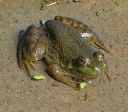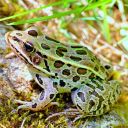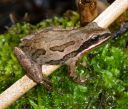Calling Calendar
Here you can view the breeding periods of frogs in order to better narrow down what frog species you should be hearing during the given month. The Keweenaw area is located within Zone 4.
Here you can view the breeding periods of frogs in order to better narrow down what frog species you should be hearing during the given month. The Keweenaw area is located within Zone 4.

Size: 3 1/2" to 8". Our largest frog in Michigan but not very common locally. Greenish yellow with random mottling. Cream colored belly with lighter gray spots. Sound: A deep 'juga-rum' or 'drum'.

Size: 2 1/8" to 4". Green or brownish colored frog with green upper lip. Large eardrum. White belly with black spots. Sounds like banjo strings.

Size: 1 3/8" to 3 1/4". Breeds early in spring then disappears into moist woodlands. Note short black mask. Sound: Like rubbing finger on wet balloon.

Size: 1 7/8" to 3". Olive to brown in color with uniform mottling along sides and legs. Pungent mink-like odor. Yellowish colored belly. Sound: Like knocking on wood or like popcorn popping when in full chorus.

Size: 2" to 5". Slender brown or green frog with light edges around irregularly shaped spots. Sound: Low croaking snore that lasts for several seconds.

Size: 1 3/4" to 3 1/2". Slender green or tan frog with parallel rows of square- shaped spots down its back. Yellow belly patch by inner thigh. Sound: Soft and low snore-like croak similar to leopard frog only softer and shorter.

Size: 1 1/4" to 2 3/8". Rarely venture from the trees. Bight green to gray usually with splotches of grey. Sticky texture. Bight yellow patches underside of hind legs. Sound: A short trill that sounds like a raccoon.

Size: 1 1/4" to 2 3/8". Rarely venture from the trees. Bight green to grey usually with splotches of grey. Sticky texture. Bight yellow patches underside of hind legs. Sound: Similar to Eastern Gray Treefrog but faster, higher pitched trill with more buzzy quality.

Size: 3/4" to 1 3/8". One of our smallest and most abundant tree frogs. Note the brown color and X mark on its back. Sound: Loud peeping.

Size: 3/4" to 1 1/2". Breeds very early, often while snow remains. A tree frog with long black mask and three dark stripes down its back. Sound: Stumming a comb with your thumb.

Size: 5/8" to 1 1/2". Very rare tiny tree frog that looks almost black. Has a dark triangle between eyes. Sound: Tapping stones together.

Size: 2" to 4 3/8". Large bumpy brown to greenish colored toad. Sound: A long, high-pitched trill that lasts about 15-30 seconds.
The survey is best taken in swampy environments where frogs are commonly found. However, surveying should not occur on evenings with lightning, heavy rain (though mist and light rain that does not affect hearing is fine), or when wind speeds are consistently greater than 12 mph (19 kmh). Surveying also should not occur when air temperatures are less than 42 degrees Fahrenheit (5.6 degrees Celsius).
1. Scout the site. Obtain site maps and access instructions, including permission to enter private property. Select only sites with suitable habitat. Visit the site in the daytime prior to beginning surveys to familiarize yourself with the area. If you are surveying more than one site, change the order of the site visits with each survey, e.g., if there are 5 sites, survey 1-2-3-4-5 first, then 2-3-4-5-1, then 3-4-5-1-2, etc. If you intend to survey long-term, do not vary from initially selected sampling sites - monitor the same sites year after year.
2. Survey effort. Surveys should be conducted approximately once per week. Select an evening when weather conditions are met. It is okay to miss one survey per month, but if more are missed, false absences may increase.
3. Gas. Make sure any vehicles have enough gas to complete the routes.
4. Safety. Tell someone where you are going before heading out for the evening. Enlist a partner whenever possible for safety.
5. Equipment. Make sure you have all necessary equipment, including, but not limited to, a map, a flashlight, a stopwatch (or other time piece), a thermometer, a first aid kit, and proper clothing.
1. Begin call surveys 30 minutes after sunset.
2. At each call site, quietly wait 2-3 minutes after arriving at the listening post before starting the stopwatch for a 5-minute survey. During this time, expose the thermometer bulb to the air so it begins equalizing with the air temperature, and fill out the preliminary weather and time information on the data form. Start the survey, recording frogs heard. At the end of the 5 minutes, take the water temperature and fill in the remaining data.
3. Listen to and record frogs from the wetland being monitored, but also record frogs heard in the distance as "distant" calls and note the direction. Distance calls are from other wetlands, not the one you are monitoring.
4. Any time noise from passing vehicles, storms, etc. makes hearing impossible, elapsed time should be stopped on the stopwatch at the point of interruption and continued afterwards until the survey has been conducted for the full five minutes.
5. You may record any birds or other wildlife detected in the Comments section, along with any comments or anything you think may have disturbed the survey.
1. Store equipment. Place all wet equipment in a place where it can dry.
2. Ensure the survey was successfully submitted. Congratulate yourself on a job well done!